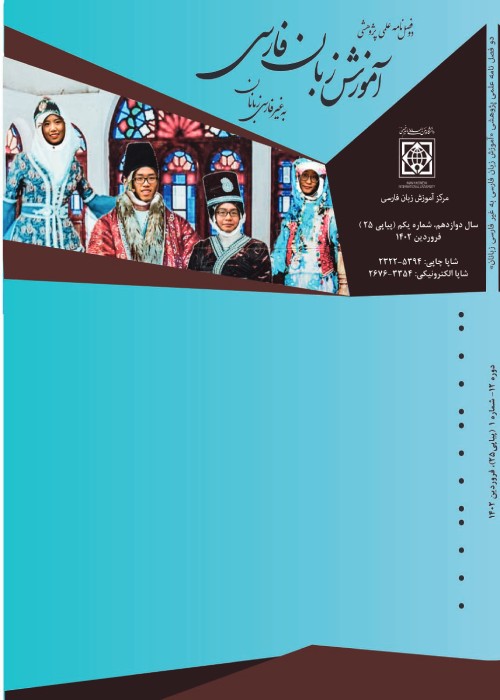Teaching transitive/intransitive Persian motion verbs to non-native learners: A cognitive approach for recognizing transitivity and conceptualizing motion verbs
Author(s):
Article Type:
Research/Original Article (دارای رتبه معتبر)
Abstract:
The present study explored sentences in which motion verbs had been used. Recognition of transitivity is very important for language learners since it would help them identify the object of the sentence and insert “ra” after it as object marker. It would also help in deciding whether a structure could be passivized or not. Since foreign learners of Persian language do not have native speaker intuitions about Persian grammar, recognition of transitivity is a learning problem for them. Also, conceptualizing motion verbs poses difficulties for Persian language learners. Therefore, in this study after classification of motion verbs, transitivity characteristics were also considered as a factor for prediction. 24 fifth level language learners at the International College of Tehran University of Medical Sciences participated in this study. They were assigned to two equal sized groups. The first group was considered as the experimental group and received instruction within Talmy’s (2000) theoretical framework. The second group which acted as the control group received ordinary instruction. Based on the instructor’s subjective evaluation and the results of the written test, the experimental group achieved better conceptualization of new verbs. Expanded Abstract The present study explored the notion of teaching transitivity of motion verbs. Recognition of transitivity is very important for Persian language learners. The importance of this structure in Persian is related to its use. On the one hand, the learners can guess whether they can use direct object and its marker (rā) or not, on the other hand, they can decide about using passive structure. Since the learners do not have native speaker intuitions about Persian grammar, recognition of transitivity is a difficult subject for them. Motion events involve situations encompassing movement or the maintenance of a stationary location. According to Talmy (2000), the basic motion event consists of one object (the ‘Figure’) moving or located with respect to another object (the reference-object or ‘Ground’). Besides these two components, its semantic structure has two internal components, i.e. ‘Path’ and ‘Motion’. The ‘Path’ is the course followed or the site occupied by the Figure object with respect to the Ground object, and the ‘Motion’ refers to the presence in the event of motion or location. Considering only the dynamic motion event (MOVE) and leaving the result of a motion (BE Loc) aside, we deal with the linking of semantic and syntactic properties. Following Talmy (2000), Persian language motion verbs are classified in fifteen groups, and one schematic representation was considered for each of them. In this study referential verbs describe a motion event only when their object denotes a location-type entity. After classifying Persian verbs into transitive and intransitive verbs, there is a semantic analysis based on their figure and grounds. All the subjects in intransitive structures are figures and the figures experience change in their location or move from a source to a goal. While, in transitive motion events, verbs are classified in three types; referential, relational, or causative. There is distinction between two types of linguistically defined entities: an object vs. a location. A location refers to a stable spatial fragment within a given frame of reference. An object refers to a material entity, not necessarily stable, within a frame of reference. Moreover, relational verbs such as ‘cross’, ‘pass’, and ‘climb’ do not implement any selectional limitations on the object/location alternation. They describe a motive relation between two implicit regions first defined in relation to each other. The semantic role considered as prototypical for the direct object is the Patient. And transitive structure followed this structure: NP1 Vtrans NP2. It means that all transitive structures in Persian language should apply one noun phrase as their direct objects and prototypically it is the patient of the verb. 24 participants of the study were in the fifth level of the International College of Tehran University of Medical Sciences and were assigned to two equal sized groups. The first group was considered the experimental group. After classification of motion verbs, the transitivity characteristics should also be considered as a factor for prediction. The results revealed that the experimental group had a better understanding of the transitivity of motion verbs in Persian Language. Based on the results of the present study which involved two groups of L2learners who underwent 16trainingsessions,it was found that the experimental group had a better understanding of motion verbs and its members better understood the meaning of new verbs.
Keywords:
Language:
Persian
Published:
Journal of Teaching Persian to Speakers of Other Languages, Volume:8 Issue: 17, 2019
Pages:
109 to 126
magiran.com/p2043496
دانلود و مطالعه متن این مقاله با یکی از روشهای زیر امکان پذیر است:
اشتراک شخصی
با عضویت و پرداخت آنلاین حق اشتراک یکساله به مبلغ 1,390,000ريال میتوانید 70 عنوان مطلب دانلود کنید!
اشتراک سازمانی
به کتابخانه دانشگاه یا محل کار خود پیشنهاد کنید تا اشتراک سازمانی این پایگاه را برای دسترسی نامحدود همه کاربران به متن مطالب تهیه نمایند!
توجه!
- حق عضویت دریافتی صرف حمایت از نشریات عضو و نگهداری، تکمیل و توسعه مگیران میشود.
- پرداخت حق اشتراک و دانلود مقالات اجازه بازنشر آن در سایر رسانههای چاپی و دیجیتال را به کاربر نمیدهد.
دسترسی سراسری کاربران دانشگاه پیام نور!
اعضای هیئت علمی و دانشجویان دانشگاه پیام نور در سراسر کشور، در صورت ثبت نام با ایمیل دانشگاهی، تا پایان فروردین ماه 1403 به مقالات سایت دسترسی خواهند داشت!
In order to view content subscription is required
Personal subscription
Subscribe magiran.com for 70 € euros via PayPal and download 70 articles during a year.
Organization subscription
Please contact us to subscribe your university or library for unlimited access!


